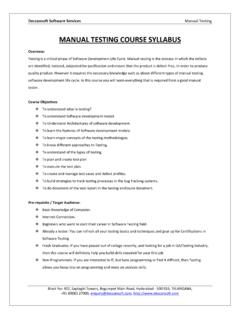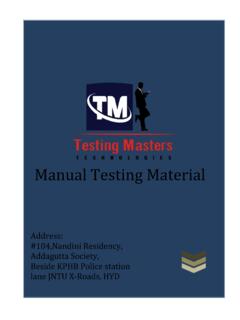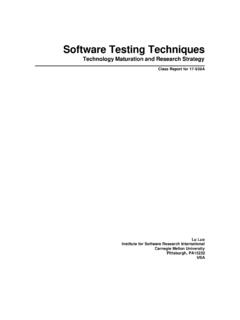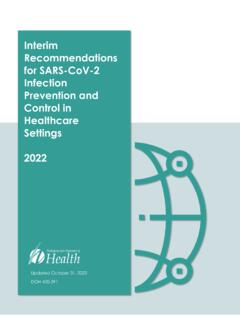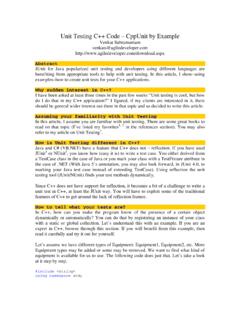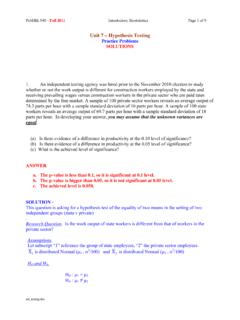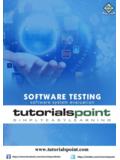Transcription of Manual Testing Step by Step Tutorial - Software Testing
1 G C Reddy Technologies ( ) G C Reddy Technologies ( ) Manual Testing step by step Tutorial 1) Software Development Life Cycle and SDLC Model i) Requirement Gathering ii) Analysis iii) Design iv) Coding / Development v) Testing vi) Deployment & Maintenance SDLC Models i) Waterfall Model ii) V Model 2) Software Test Levels i) unit Testing ii) Integration Testing iii) System Testing iv) Acceptance Testing 3) Software Test Types i) Functional Testing ii) Non-functional Testing iii) Structural Testing iv) Change related Testing 4) Software Test Design Techniques i) Static Test Design Techniques a) Reviews ( Manual Examination) 1) Informal Review 2) Walk through 3) Technical Review 4) Inspection b) Static Analysis (Automated Analysis) G C Reddy Technologies ( ) G C Reddy Technologies ( ) ii) Dynamic Test Design Techniques a) Specification based or Black box Techniques 1) Equivalence Partitioning (EP) 2) Boundary Value Analysis (BVA) 3) Decision Table Testing 4) State Transition Testing 5) Use Case Testing b) Structure based or White box Techniques 1) Statement Coverage 2) Decision Coverage 3) Condition Coverage 4) Multi Condition Coverage 5) LCSAJ c) Experience based Techniques 1) Error Guessing 2) Exploratory Testing 5) Software Test Life Cycle i) Requirement Analysis ii) Test Planning iii) Test Design & Development iv) Test Environment Setup v) Test Execution vi) Test Cycle Closure Manual Testing step step Videos 1) Software Development Life Cycle and SDLC Model Software Development Life Cycle > Software Development Life Cycle is a systematic approach to develop Software .
2 It is a Process followed by Software Developers and Software Testing is an integral part of Software Development, so it is also important for Software > Software Development Life Cycle (SDLC) is a process used by the Software industry to design, develop and test Software . The SDLC aims to produce a high-quality Software that meets or exceeds customer expectations, reaches completion within times and cost estimates. G C Reddy Technologies ( ) G C Reddy Technologies ( ) > ISO/IEC 12207 is an international standard for Software life-cycle processes. It defines all the tasks required for developing and maintaining Software . Phases of Software Development Life Cycle, These phases may vary form one organization to another, but purpose is almost all same, that is "Develop and Maintain Quality Software ", i) Requirement Gathering ii) Analysis iii) Design iv) Coding / Development v) Testing vi) Deployment & Maintenance Note: It is General Software Development Life Cycle, we have various SDLC Models in the IT Industry, Waterfall Model, V Model, Spiral Model and Agile Development Models , Software Development process varies from one SDLC Model to another.
3 I) Requirement Gathering > Requirement Gathering is the most important phase in Software development life cycle, Business Analyst collects the requirements from the Customer/Client as per the clients business needs and documents the requirements in the Business Requirement Specification and provides the same to Development Team. Note: Document name may vary from one Organization to another, Some examples are Customer Requirement Specification (CRS), Business Requirement Document (BRD) > Suppose Our Planned Software is not intended for a single customer and the Software product for multiple customers then Business Analyst or Business Team collects Requirements from the Market and also evaluate Other similar products in the Market > Key Role in this phase is Business Analyst and Outcome of the phase is "Business Requirement Specification" G C Reddy Technologies ( ) G C Reddy Technologies ( ) ii) Analysis > Once the Requirement Gathering is done the next step is to define and document the product requirements and get them approved by the customer.
4 This is done through SRS ( Software Requirement Specification) document. SRS consists of all the product requirements to be designed and developed during the project life cycle. > Key people involved in this phase are Project Manager, Business Analyst and Senior members of the Team. The outcome of this phase is Software Requirement Specification. iii) Design > In Design phase Senior Developers and Architects, they give the architecture of the Software product to be developed. It has two steps one is HLD (High Level Design) or Global Design and another is LLD (Low Level Design) or Detailed Design, > High Level Design (HLD) is the overall system design, covers the system architecture and database design. It describes the relation between various modules and functions of the system. > Low Level Design (LLD) is the detailed system design, covers how each and every feature in the product should work and how every component should work. > The outcome of this phase is High Level Document and Low Level Document which works as an input to the next phase iv) Coding / Development > Developers (seniors, juniors and fresher) involved in this phase, this is the phase where we start building the Software and start writing the code for the product.
5 > The outcome of this phase is Source Code Document (SCD) and the developed product. v) Testing > Once the Software is complete then it is deployed in the Testing environment. The Testing team starts Testing (either test the Software manually or using automated test tools depends on process defined in STLC) G C Reddy Technologies ( ) G C Reddy Technologies ( ) > Testing is done to verify that the entire application works according to the customer requirement. > During this phase, Testing team may find defects which they communicate to developers, the development team fixes the defect and send back to Testing for a re-test. This process continues until the Software is Stable, and working according to the business needs of that system. vi) Deployment & Maintenance > After successful Testing , the product is delivered (deployed to the customer for their use), Deployment is done by the Deployment/Implementation engineers and Once when the customers start using the developed system then the actual problems will come up and needs to be solved from time to time.
6 > Fixing the issues found by the customer comes in the maintenance phase. 100% Testing is not possible because, the way testers test the product is different from the way customers use the product. Maintenance should be done as per SLA (Service Level Agreement) Software Development Life Cycle Models > There are various Software development life cycle models defined and designed which are followed during the Software development process. These models are also referred as Software Development Process Models". i) Waterfall Model > Waterfall approach was first SDLC Model to be used widely in Software Engineering to ensure success of the project. In "The Waterfall" approach, the whole process of Software development is divided into separate phases. In this Waterfall model, typically, the outcome of one phase acts as the input for the next phase sequentially. Phases of Waterfall Model: a) Requirements Gathering: > This first step is also the most important, because it involves gathering information about what the customer needs and defining, in the clearest possible terms, the problem that the product is expected to solve.
7 G C Reddy Technologies ( ) G C Reddy Technologies ( ) b) Software Requirements: > In this phase Business Requirements are converted as Software Requirements. c) Design: > In this phase Global and Detailed design can be produced based on Software Requirements. d) Coding: > This step consists of actually constructing the product as per the design specification(s) developed in the previous step . Typically, this step is performed by a development team consisting of programmers, interface designers and other specialists, using tools such as compilers, debuggers, interpreters and media editors. The output of this step is one or more product components, built according to a pre-defined coding standard and debugged, tested and integrated to satisfy the system architecture requirements. e) Testing : > In this stage, System will be tested by testers, if the find any mismatch they report defects. Developers /Programmers fix the defects and then testers close defects by performing confirmation Testing (Regression Testing ).
8 F) Release & Maintenance: > Release team (consists of a few developers, testers, and tech-support people ) install Software in Customer environment and they consider below factors; Correct & Complete installation, User Management, Services Management, Coexistence with other Software , Handling of Input & Output devices, and Handling of secondary storage devices Maintenance team process Customer issues based on service agreements. Advantages of Waterfall Model: a) Simple and easy to use G C Reddy Technologies ( ) G C Reddy Technologies ( ) b) Easy to manage due to the rigidity of the model- each phase has specific deliverables and a review process. c) Phases are processed and completed one at a time. d) Works well for smaller projects where requirements are very well understood. Disadvantages of Waterfall Model: a) No working Software is produced until late during the life cycle b) High amount of risk and uncertainty c) Poor model for complex and object oriented projects.
9 D) Poor model for Long and ongoing projects e) Poor Model where requirements are at a moderate to high risk of changing. ii) V Model > It is Verification & Validation model, known as V Model, in this model all development phases can be integrated with Testing phases. > The V-model illustrates how Testing activities can be integrated into each phase of the Software development life cycle. > V Model was inaugurated in order to avoid drawbacks in Waterfall model and its main focus on multiple stages of Testing . > Multiple stages of Testing avoids defects multiplication. Development Phases Integration with Testing Phases a) User Requirements Vs Acceptance Testing > Business Analyst category people gather requirements and the document the requirements, after documentation Reviews, Meetings like verification will take place in order get correct & Complete Requirements. End Users conduct Acceptance Testing using Business / User Requirements.
10 G C Reddy Technologies ( ) G C Reddy Technologies ( ) b) Software Requirements Vs System Testing > Development Manager/Tech Manager converts User Requirements as Software Requirements and Reviews, Meetings like verification methods will be performed on Software Requirements, after Verification Project manager provides Approval. > Independent testers generate test cases from Software Requirements in order to perform System Testing c) Global Design Vs Integration Testing > System Architect / senior developer creates Global design, Informal Review/ Walk through / Technical Review / Inspection like Verification methods will be applied on Design documents. > Developers perform Integration Testing based on Software Global Design. d) Detailed Design Vs unit / Component Testing > Developers perform unit /Component Testing based on Software Detailed Design. Advantages of V Model: a) Tester role will take place in the requirement phase it self b) Multiple stages of Testing available so that Defects multiplication can be reduced.
